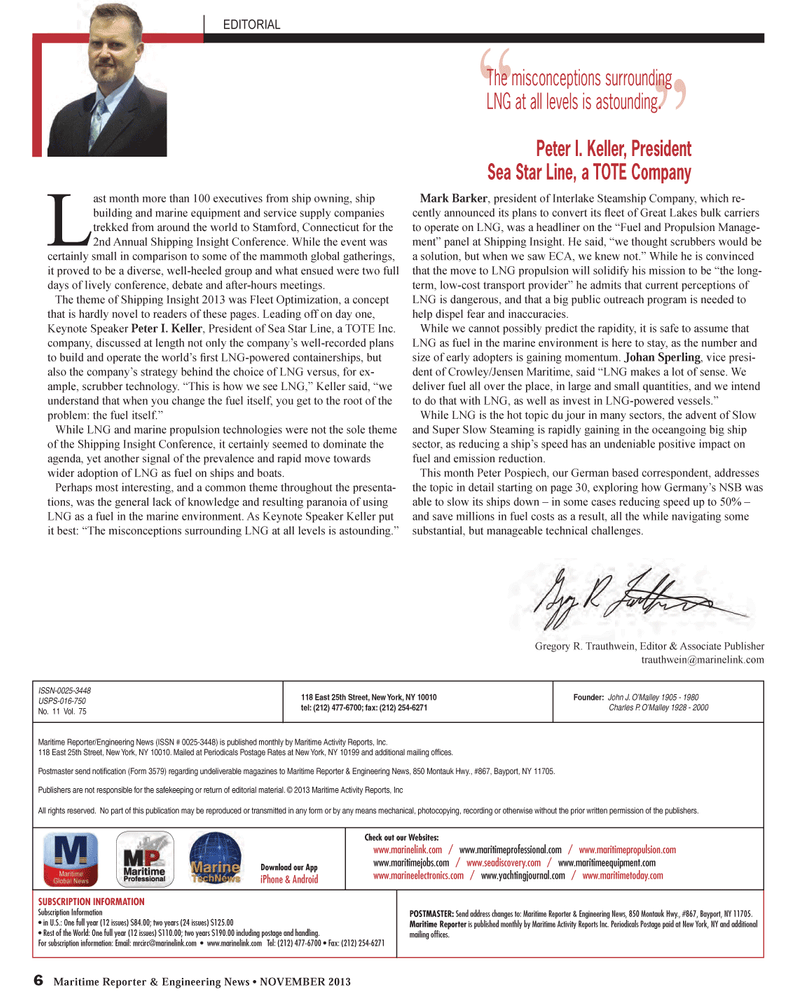
Page 6: of Maritime Reporter Magazine (November 2013)
Marine Propulsion Annual
Read this page in Pdf, Flash or Html5 edition of November 2013 Maritime Reporter Magazine
6 Maritime Reporter & Engineering News ? NOVEMBER 2013 SUBSCRIPTION INFORMATION Subscription Information in U.S.: One full year (12 issues) $84.00; two years (24 issues) $125.00 Rest of the World: One full year (12 issues) $110.00; two years $190.00 including postage and handling. For subscription information: Email: [email protected] www.marinelink.com Tel: (212) 477-6700 Fax: (212) 254-6271 POSTMASTER: Send address changes to: Maritime Reporter & Engineering News, 850 Montauk Hwy., #867, Bayport, NY 11705. Maritime Reporter is published monthly by Maritime Activity Reports Inc. Periodicals Postage paid at New York, NY and additional mailing of ces. ISSN-0025-3448USPS-016-750No. 11 Vol. 75 Maritime Reporter/Engineering News (ISSN # 0025-3448) is published monthly by Maritime Activity Reports, Inc. 118 East 25th Street, New York, NY 10010. Mailed at Periodicals Postage Rates at New York, NY 10199 and additional mailing ofÞ ces. Postmaster send notiÞ cation (Form 3579) regarding undeliverable magazines to Maritime Reporter & Engineering News, 850 Montauk Hwy., #867, Bayport, NY 11705. Publishers are not responsible for the safekeeping or return of editorial material. © 2013 Maritime Activity Reports, Inc All rights reserved. No part of this publication may be reproduced or transmitted in any form or by any means mechanical, photocopying, recording or otherwise without the prior written permission of the publishers. Check out our Websites: www.marinelink.com / www.maritimeprofessional.com / www.maritimepropulsion.com www.maritimejobs.com / www.seadiscovery.com / www.maritimeequipment.com www.marineelectronics.com / www.yachtingjournal.com / www.maritimetoday.com 118 East 25th Street, New York, NY 10010 tel: (212) 477-6700; fax: (212) 254-6271 Founder: John J. O?Malley 1905 - 1980 Charles P. O?Malley 1928 - 2000 Download our AppiPhone & AndroidEDITORIAL Gregory R. Trauthwein, Editor & Associate Publisher [email protected] month more than 100 executives from ship owning, ship building and marine equipment and service supply companies trekked from around the world to Stamford, Connecticut for the 2nd Annual Shipping Insight Conference. While the event was certainly small in comparison to some of the mammoth global gatherings, it proved to be a diverse, well-heeled group and what ensued were two full days of lively conference, debate and after-hours meetings. The theme of Shipping Insight 2013 was Fleet Optimization, a concept that is hardly novel to readers of these pages. Leading off on day one, Keynote Speaker Peter I. Keller , President of Sea Star Line, a TOTE Inc. company, discussed at length not only the company?s well-recorded plans to build and operate the world?s Þ rst LNG-powered containerships, but also the company?s strategy behind the choice of LNG versus, for ex- ample, scrubber technology. ?This is how we see LNG,? Keller said, ?we understand that when you change the fuel itself, you get to the root of the problem: the fuel itself.?While LNG and marine propulsion technologies were not the sole theme of the Shipping Insight Conference, it certainly seemed to dominate the agenda, yet another signal of the prevalence and rapid move towards wider adoption of LNG as fuel on ships and boats.Perhaps most interesting, and a common theme throughout the presenta-tions, was the general lack of knowledge and resulting paranoia of using LNG as a fuel in the marine environment. As Keynote Speaker Keller put it best: ?The misconceptions surrounding LNG at all levels is astounding.?Mark Barker, president of Interlake Steamship Company, which re- cently announced its plans to convert its ß eet of Great Lakes bulk carriers to operate on LNG, was a headliner on the ?Fuel and Propulsion Manage-ment? panel at Shipping Insight. He said, ?we thought scrubbers would be a solution, but when we saw ECA, we knew not.? While he is convinced that the move to LNG propulsion will solidify his mission to be ?the long-term, low-cost transport provider? he admits that current perceptions of LNG is dangerous, and that a big public outreach program is needed to help dispel fear and inaccuracies.While we cannot possibly predict the rapidity, it is safe to assume that LNG as fuel in the marine environment is here to stay, as the number and size of early adopters is gaining momentum. Johan Sperling, vice presi-dent of Crowley/Jensen Maritime, said ?LNG makes a lot of sense. We deliver fuel all over the place, in large and small quantities, and we intend to do that with LNG, as well as invest in LNG-powered vessels.?While LNG is the hot topic du jour in many sectors, the advent of Slow and Super Slow Steaming is rapidly gaining in the oceangoing big ship sector, as reducing a ship?s speed has an undeniable positive impact on fuel and emission reduction. This month Peter Pospiech, our German based correspondent, addresses the topic in detail starting on page 30, exploring how Germany?s NSB was able to slow its ships down ? in some cases reducing speed up to 50% ? and save millions in fuel costs as a result, all the while navigating some substantial, but manageable technical challenges.??The misconceptions surrounding LNG at all levels is astounding.Peter I. Keller, President Sea Star Line, a TOTE CompanyMR #11 (1-9).indd 6MR #11 (1-9).indd 611/13/2013 11:54:19 AM11/13/2013 11:54:19 AM

 5
5

 7
7
